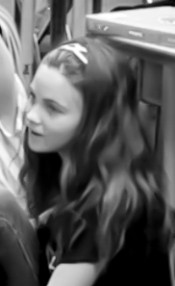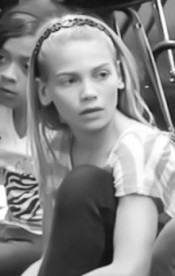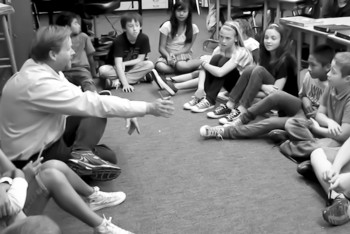How can a cloud hold water?
Fourth graders become animated discussing water, clouds, and evaporation.
Fourth-graders Jordan and Elea convince their class to ask how a cloud holds water.
Background
Project
This is another episode is from the project Responsive Teaching in Science, which was funded by the National Science Foundation and focused on cultivating instructional practices of attending and responding to student thinking. The project involved professional development for the participating teachers, and everyone collaborated in developing ideas for responsive curricula.
Class
Chris Myers’ fourth grade class, in an urban west-coast public elementary school, was studying the water cycle. For the project, he and the other fourth-grade teachers opened their unit with a launching question:
“One night it rains. When you arrive at school, you notice that there are puddles in the parking lot. When you go home, the puddles are gone. What happened to the rainwater?”
This was in May, near the end of the school year. In previous science discussions, students had engaged in generating ideas and offering arguments to support and refute their ideas, but they had never really taken charge of the discussion themselves, something Mr. Myers was hoping they would do.
Episode
After several days into the unit, clouds had become a central player in students’ conversations and notebooks. Mr. Myers noted this and decided to ask students to expand on their ideas about clouds. Hoping to help get them talking more among themselves, he had them sit in a circle on the floor for conversation.
He first explained what they would be doing after the conversation, and then he called on Alyssa.
“I’m gonna ask you to go back to your seat and draw for me what you think happens in a cloud… I wanna know really clearly how is it that a cloud rains. So let’s start over here with Alyssa who has her hand up. And I want to be able to get out of the middle here.”
The episode opens with Alyssa explaining her idea.
What about clouds?

Mr. Myers’s fourth-grade class has been discussing evaporation and rain as part of a unit on the water cycle. On this day, he asks the students what they think happens in a cloud.

"What's in a cloud that makes it hold the water?"
Alyssa responds that clouds collect water and it rains when the clouds get too heavy. Jordan starts to answer the teacher’s question, but then asks her own question about how a cloud holds water.

"Yeah, coz it’s light as a feather."
Trying to draw other students into the conversation, Mr. Myers asks Jordan to repeat her question. Elea adds that a cloud is “light as a feather,” and so she doesn’t think it does hold water. Jordan supposes the water could be a gas in a cloud and “something happens” for it to turn into a liquid when it rains. Still trying to draw others in, Mr. Myers again asks Jordan to repeat her idea. This time, Jordan argues: “the water would be too heavy for a cloud, and everyone says it’s light.”

"It just holds as much as it can."
When Alyssa speaks of a cloud holding “as much as it can,” Jordan and Elea speak directly to her, without waiting for Mr. Myers. They turn to face each other, asking questions and presenting arguments. With increasing animation, Elea and Jordan insist that there needs to be a sensible mechanism for how a cloud holds water.
At this point, Mr. Myers interrupts to support what the girls are doing but to ask that they make space for other students.

"What you guys just did is something I tried… to get you guys to do."
After Mr. Myers finishes speaking, the students return to speaking to him rather than to each other. When Alyssa still doesn’t address how a cloud holds water, the intensity quickly returns as Jordan and Elea challenge her to answer their question. As the conversation continues, other students join in to consider how water can be in a cloud. Alyssa challenges the idea that clouds are “that light” because of her experience that it’s bumpy when a plane goes through a cloud. Elea is not convinced, saying you can put your hand through a cloud.
Reflections
Why is this science?
There are several features that make this an episode of students, particularly Jordan and Elea, doing science.
First, they are recognizing and trying to articulate questions about whether and how a cloud holds water. Jordan first asked “what’s in a cloud that makes it hold the water” and then “how could water be in a cloud without falling?” Elea raised the related issue of weight: A cloud is “light as a feather,” so how could it hold heavy water.
Second, they are holding each other accountable to sensible, consistent reasoning. Jordan and Elea insist that there’s a question to answer, how a cloud can hold water. When one student suggests that the water stays in a cloud because there is no gravity, Jordan argues there has to be gravity for water to fall.
Finally, they draw on evidence to support or challenge explanations. Alyssa does this, when she cites the experience of bumpiness when planes go through clouds, to challenge the idea that clouds are necessarily light; Elea responds with other evidence that a cloud feels like air.
In these ways, students in this episode are trying to arrive at clear, sensible, consistent accounts of the phenomena of clouds and rain.
What contributed?
This episode stood out because it was, according to Mr. Myers, the first time these students began interacting directly with one another during their science inquiries. We describe below several factors that seem to have contributed.
The students took ownership of the inquiry
When we first saw this episode, we were struck by the dramatic shift in the third video. We later realized that this shift didn’t happen all at once, that the students had actually started to take ownership earlier.
The first moment was Jordan’s asking her own question, instead of responding to Mr. Myers’s prompt. Elea took up Jordan’s question, arguing against the idea that clouds hold water, and responding as well to Alyssa, although still directing her talk to the teacher. When Alyssa responded without acknowledging Jordan’s question, the girls stopped waiting to be called on and began speaking directly to each other. Soon the students were the leaders of the discussion, providing new ideas and evaluating each other’s contributions.
The students felt strongly about their questions
Jordan’s initial question emerged from her realizing there was something she did not understand, how a cloud can hold water. Elea saw it, too, but when others did not, especially Alyssa, Jordan and Elea became impassioned about getting them to recognize the problem. Their strong feelings spurred them to take greater ownership of the conversation, in particular to stop waiting for the teacher to call on them. That feistiness seemed to draw others into the conversation.
There are other aspects of students’ affect at play as well, such as the joy and excitement in formulating and expressing ideas freely and the feeling of accomplishment and pride in taking ownership of the conversation.
The students’ knowledge and abilities
Perhaps most obviously, the students had relevant knowledge and abilities to pose these questions and to start to think about possible answers.
What they know about how physical objects behave, from everyday experience, if they apply it to clouds and rain, raises these questions. Heavy things fall if there is nothing holding them up. How can clouds hold water up? Clouds are nothing like containers — they don’t have a “wall” or a “patch”; they are airy. How can clouds be light and hold water, which is heavy?
They also have knowledge for starting to think about the question, such as that water can turn into a gas and then “back into water” (that is a liquid). They know that something about clouds can make an airplane ride very bumpy, so perhaps there is more to clouds than it seems.
Finally, they know how to engage in this other kind of activity, in the give-and-take of lively conversation. They can listen to each others’ ideas, assess and respond with reasoning and evidence, at least at this beginning level. If they haven’t been doing this in class, it is not for lack of ability.
See PDF transcript for full length video.
Responsive Teaching
For more about Responsive Teaching in Science, see the following links to the project site:
Description of Responsive Teaching
More about the Responsive Teaching Project’s work on the water cycle
Publications
Lama Jaber and David Hammer analyze this episode as part of an article focused on affect in science:
Jaber, L. & Hammer, D. (in press). Learning to feel like a scientist. Science Education.
Grant Reference
Goldberg, F. M., Hammer, D. M., Bendall, S., & Coffey, J. (2008-2011). Learning Progression for Scientific Inquiry: A Model Implementation in the Context of Energy. San Diego State University and University of Maryland: National Science Foundation (DRL 0732233).
